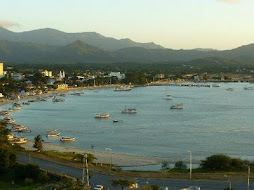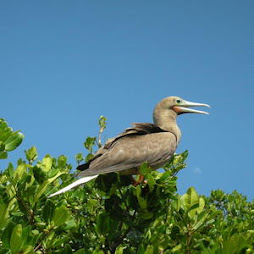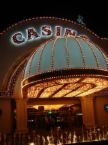Margarita Island is one of the most interesting destinations in the Caribbean. It is a beautiful place to visit and enjoy. It has natural beauties and attractions, a perfect starting point to enjoy the exhuberant Venezuela with it´s tropical rainforest, impressive waterfalls and rivers, paradise-like islands, surprising snow-covered mountain ranges, desert- like dunes and imposing plains with it´s large diversity of flora and fauna.
The Island itself is an example of contrasts. Porlamar , with it´s modern buildings and sofisticated boutiques offering the very best of the world in clothing and decorations….Bodegones (delikatessen) full with fine vines and exquisite food imported from all over the world….the Free Market Conejeros… handcarft stores…..picturesque kiosques offering fried fish, cachapas (kind of a corn pancake), cocadas…restaurants offering French, Italian, Japanese and International dishes as well as local ones. And the villages, with its ever present shaded plaza,…churches telling tales form other times and that always are visited by devots…..the remains of the Colonial Arquitecture…the warmth of the natives with their very own way of talking that makes them sound as if they were always joking….and of course its beaches.
Margarita Island combines the traditonal ways with modern arquitecture and comfort. Discover it and let you be charmed by it…Below see pictures, music-videos...
| The purpose of this instructional Module: Is to address the learning needs with respect to distinguishing ecological and cultural features and locations in Margarita Island. Objetives After completing this module, you should be able to (1) define ecological and cultural environment and its importance, (2) examine similarities and differences, (2) articulate a personal plan or project for yourself to enjoy Margarita Island by specifying locations and defending significant eco-cultural learning. Learning ActivitiesLearning activies are organized in four parts:I. Introductory II. The practical III. Analysis-Synthesis IV. Evaluation |
Part I. INTRODUCTORY |
By the end of the first session, the student and the group will answer the following questions: |
1.Which two of example WebPages listed below are the best ones in terms of providing you with enough information regarding eco-cultural tourism in Margarita Island? Why? |
2. Which two are the worst? Why? |
3. What do best and worst mean to you? |
4. Which other ones would you recommend? |
Instructions |
1. The instructor will be the general manager or organizer. http://www.readingonline.org/articles/art_index.asp?HREF=wilcox/index.htmlThe instructor will provide each participant with a hard copy of the Work sheet. To answer the questions given above, the student will break into groups of four. Within the group, each of the students will take on one of the following roles: |
| A. The Efficiency Expert: You are an expert on educational environment. You know all about B. The Affiliator: To you the best learning activities are those in which C. The Smart Higher level thinking is everything to you. There's too
D. The Technophile: You love Internet quest and on line modules. If web quest |
2. Individually, each student will examine each of the sites below and use the worksheet to jot down some notes of their opinions of each from the perspective of their role. Each student will need to examine each site fairly quickly. They should not spend more than 5 minutes on any one site. The student coordinator will keep time using a clock. |
The sites that will be analyzed are: |
Paths to successful touring |
Ecological tourism characteristics |
Cultural tourism: art and historical museums |
Tourism features |
3. When everyone in the group has seen all the sites, |
it's time to get together to answer the questions. |
One way to proceed would be to go around and |
poll each team member for the best two and |
worst two from their perspective. Each student |
should pay attention to each of the other perspectives, |
even if at first s/he thinks might disagree with the others. |
4. There will probably not be unanimous agreement, |
so the next step is that students talk together |
to hammer out a compromise consensus about |
each team's nominations for best and worst. |
Pool your perspectives and see if each student |
can agree on what's best. |
The coordinator should check that each group |
do not just tally up the votes and declare a winner. |
Instead, each student should begin to put aside |
his/her individual perspective and come to an agreement |
that takes into account all four perspectives. |
5. One person, the coordinator in each group |
should record the group's thoughts. |
6. When debriefing time is called, the coordinator |
will report the group's results to the whole class. |
The question to be discussed is: do you think the |
other group will agree with your conclusions? |
Also, provide a summary of the results. |
7. Finally, the instructor will ask for comments |
on the activity and get feedback from students. |
How the learners feel about the instruction? |
Did you like the experience? Any suggestions? |
Part II. THE PRACTICAL |
2.1. Read the steps to visit Margarita Island. The order was taken considering any person arriving from the Airport: |
Zone 1: Upon Arrival to Margarita Island |
2.2. Consider the information given; identify |
a problem in ecology-cultural tourism, make a plan/project |
for yourself to solve the problem, and organize your visit |
| to different places in the Island. List all the steps. |
2.3. Send by e-mail your plan or project: |
Once all of the plans have been posted in this web site Find one posting that differs from yours, and comment on the difference you found. |
Did someone think of something you overlooked? |
Did someone include something that you wouldn't want to include in yours? |
Think about it. |
What did you learn from each other? |
| Part III. ANALYSIS AND SYNTHESIS |
3.1. Complete the following required readings: |
| http://www.islamargarita.com.ve/english/margarita_island.htm |
http://www.une.edu.ve/margarita/english/index.htm |
| 3.2. Supplementary Readings: |
| www.fao.org/Regional/LAmerica/organos/coflac/situ02i |
www.beachbrowser.com/Archives/Local-News/July-2002/LINKING-TOURISM.htm |
3.3. View the following videos: |
“Music and Colors Margarita” |
| "Margarita Island and the Nature" |
| http://www.youtube.com/watch?v=UBPFkIkkDwU |
| 3.4. Take notes as you watch videos, |
much the same way as you would do normally in class, |
and answer each of the following questions: |
- How would you describe Margarita Island? |
- Could you be able to evaluate and improve your plan/tour? |
3.5. View and/or visit the following places of Margarita Island: |
Natural Monuments |
3.6. Think about what competencies and issues are |
important to you as a researcher/professional in the field. |
3.7. Make a summary based on the Study Questions: |
(A) Write at least two similarities between cultural and |
eco-tourism in Margarita Island. Provide examples. |
(B) Write at least two features that distinguish cultural |
and ecological tourism in Margarita Island. Provide examples. |
(C) Given characteristics of eco and cultural tourism in |
Margarita Island, describe in your own words a tour |
or a plan of cultural and eco-tourism in Margarita |
in a plan or project, integrating what you have |
learned into your existing knowledge and practical |
experience, providing examples. |
(D) Think about, how important is to learn Internet skills |
and the use of computers for tourist experts? |
You are not required to hand in thes questions for evaluation. |
Remember that by writing your answers down, you will be |
more likely to make sense of the content. |
3.8. Review key terms/concepts |
Match key concepts with pictures on your right hand: |
Ecological tourism |
Cultural Tourism |
Margarita Island |
Do some additional research on: |
Venezuela, Caribbean and Latin America |
3.9. Reread objectives for this module |
Think about whether you have been able to meet |
those objectives. Review your notes and lecture and |
ask your instructor for clarification where needed. |
3.10. Synthesize your final plan |
|
choosing, strategies/activities to further examine the Island. |
Select eco-cultural locations that will be useful for you |
There are two case studies you can review |
and might be used as insights for your final plan. |
http://margarita-island.viajar.com.ve/excursions_and_tours.htm |
PART IV. EVALUATION: 1. Assess your own project or plan with colleagues on the basis of the following check list: (A) Does it include clear objectives that are "connected" with contents? (B) Does it include knowledge of ecological and cultural environment? (C) Does it includes activities or experiences to learn about eco-cultural environment in Margarita Island? (D) Does it include how to evaluate and improve it? Briefly explain the strengths of your project and hand in to the instructor. |
2. Take the post-test and evaluate this module as follows: |
| Evaluate this Module: | ||
| - Identify strengths and weaknesses. | ||
| Were the specific objectives and content (disciplinary and pedagogical) accurate and up to date? | ||
| - Did the module stimulate questions, inquiry, and encourage field work? | ||
| - Were appropriate readings and resources available? | ||
| - Any suggestions to improve this site? | ||
| POST-TEST 1. What is ecological environment? 2. What is cultural environment? 3. How important is to learn about eco-cultural environment in tourism? 4. Are there any similarities/differences between both types of environment? Please mention at least 2 of each. |











































































